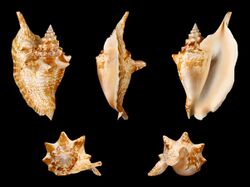Biology:Lobatus gallus
| Lobatus gallus | |
|---|---|

| |
| A shell of the rooster conch, Lobatus gallus. | |
| Scientific classification | |
| Domain: | Eukaryota |
| Kingdom: | Animalia |
| Phylum: | Mollusca |
| Class: | Gastropoda |
| Subclass: | Caenogastropoda |
| Order: | Littorinimorpha |
| Family: | Strombidae |
| Genus: | Lobatus |
| Species: | L. gallus
|
| Binomial name | |
| Lobatus gallus | |
| Synonyms | |
Lobatus gallus, previously known as Strombus gallus, common name the rooster conch or rooster-tail conch,[1] is a species of medium-sized sea snail, a marine gastropod mollusk in the family Strombidae, the true conchs.[2]
Distribution
This species is found from southeast Florida and Bermuda through the West Indies and south to Brazil .[3]
Shell description
The average shell length of this species is about 12.5 cm.[3]
The maximum recorded shell length is 197 mm.[4]
Habitat
The minimum recorded depth for this species is 0.3 m.; the maximum recorded depth is 82 m.[4]
Phylogeny
| |||||||||||||||||||||||||||||||||||||||||||||
| A simplified version of the phylogeny and relationships of Strombidae according to Simone (2005)[5] |
| |||||||||||||||||||||||||||||||||||||||||||||||||||||||||||||||
| Part of the Phylogeny and relationships of Strombidae according to Latiolais (2006)[6] |
The phylogenetic relationships among the Strombidae have been mainly accessed in two different occasions, by Simone (2005)[5] and Latiolais (2006),[6] using two distinct methods. Simone proposed a cladogram (a tree of descent) based on an extensive morpho-anatomical analysis of representatives of Aporrhaidae, Strombidae, Xenophoridae and Struthiolariidae, which included L. gallus (there referred to as Aliger gallus).[5]
With the exception of Lambis and Terebellum, the remaining taxa were previously allocated within the genus Strombus, including L. gallus. However, according to Simone, only Strombus gracilior, Strombus alatus and Strombus pugilis, the type species, remained within Strombus, as they constituted a distinct group based on at least five synapomorphies (traits that are shared by two or more taxa and their most recent common ancestor).[5] The remaining taxa were previously considered as subgenera, and were elevated to genus level by Simone in the end of his analysis. The genus Aliger (now considered a synonym of Lobatus[7]), in this case, included Aliger gallus (now considered a synonym of Lobatus gallus) and Aliger costatus (= Lobatus costatus), which were thus considered closely related.[5]
In a different approach, Latiolais and colleagues (2006) proposed another cladogram that attempts to show the phylogenetic relationships of 34 species within the family Strombidae. The authors analysed 31 species in the genus Strombus includingLobatus gallus (there referred to as Strombus gallus), and three species in the allied genus Lambis. The cladogram was based on DNA sequences of both nuclear histone H3 and mitochondrial cytochrome-c oxidase I (COI) protein-coding gene regions. In this proposed phylogeny, Strombus gigas (= Lobatus gigas) and Strombus gallus are closely related and appear to share a common ancestor.[6]
References
- ↑ Dance P. S. (1977). The Encyclopedia of Shells. Blandford Press, Dorset. 82-83. ISBN:0-7137-0698-8.
- ↑ Lobatus gallus (Linnaeus, 1758). WoRMS (2010). Lobatus gallus (Linnaeus, 1758). Accessed through: World Register of Marine Species at http://www.marinespecies.eu/aphia.php?p=taxdetails&id=565364 on 25 October 2010 .
- ↑ 3.0 3.1 Abbott, R. T.; Dance, S. P. (2000). Compendium of Seashells. Odyssey Publishing, California. p. 76. ISBN:0-9661720-0-0
- ↑ 4.0 4.1 Welch J. J. (2010). "The "Island Rule" and Deep-Sea Gastropods: Re-Examining the Evidence". PLoS ONE 5(1): e8776. doi:10.1371/journal.pone.0008776.
- ↑ 5.0 5.1 5.2 5.3 5.4 Simone, L. R. L. (2005). "Comparative morphological study of representatives of the three families of Stromboidea and the Xenophoroidea (Mollusca, Caenogastropoda), with an assessment of their phylogeny". Arquivos de Zoologia (São Paulo, Brazil: Museu de Zoologia da Universidade de São Paulo) 37 (2): 141–267. ISSN 0066-7870. Archived from the original on 5 March 2012. https://web.archive.org/web/20120305152402/http://www.revistasusp.sibi.usp.br/pdf/azmz/v37n2/a01v37n2.pdf.
- ↑ 6.0 6.1 6.2 Latiolais J. M., Taylor M. S., Roy K. & Hellberg M. E. (2006). "A molecular phylogenetic analysis of strombid gastropod morphological diversity". Molecular Phylogenetics and Evolution 41: 436-444. doi:10.1016/j.ympev.2006.05.027. PDF.
- ↑ Lobatus Swainson, 1837. Retrieved through: World Register of Marine Species on 5 December 2012.
Further reading
- Rosenberg, G., F. Moretzsohn, and E. F. García. 2009. Gastropoda (Mollusca) of the Gulf of Mexico, Pp. 579–699 in Felder, D.L. and D.K. Camp (eds.), Gulf of Mexico–Origins, Waters, and Biota. Biodiversity. Texas A&M Press, College Station, Texas
External links
- "Lobatus (Aliger) gallus" (in en). Gastropods.com. http://www.gastropods.com/6/Shell_216.shtml.
Wikidata ☰ Q3500525 entry


